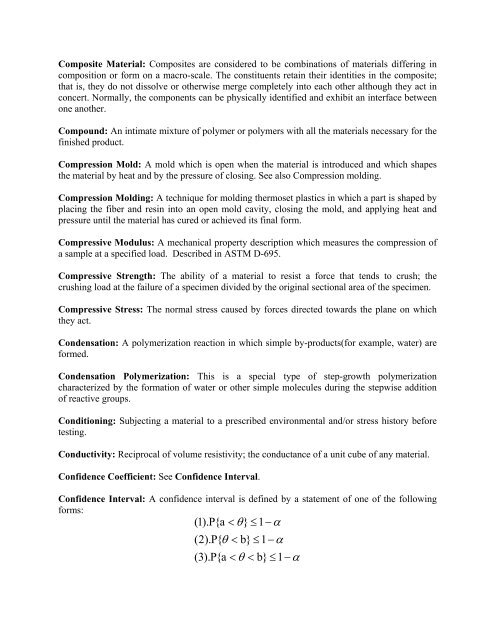Definitions /Dictionary/Glossary - nptel
Definitions /Dictionary/Glossary - nptel
Definitions /Dictionary/Glossary - nptel
You also want an ePaper? Increase the reach of your titles
YUMPU automatically turns print PDFs into web optimized ePapers that Google loves.
Composite Material: Composites are considered to be combinations of materials differing in<br />
composition or form on a macro-scale. The constituents retain their identities in the composite;<br />
that is, they do not dissolve or otherwise merge completely into each other although they act in<br />
concert. Normally, the components can be physically identified and exhibit an interface between<br />
one another.<br />
Compound: An intimate mixture of polymer or polymers with all the materials necessary for the<br />
finished product.<br />
Compression Mold: A mold which is open when the material is introduced and which shapes<br />
the material by heat and by the pressure of closing. See also Compression molding.<br />
Compression Molding: A technique for molding thermoset plastics in which a part is shaped by<br />
placing the fiber and resin into an open mold cavity, closing the mold, and applying heat and<br />
pressure until the material has cured or achieved its final form.<br />
Compressive Modulus: A mechanical property description which measures the compression of<br />
a sample at a specified load. Described in ASTM D-695.<br />
Compressive Strength: The ability of a material to resist a force that tends to crush; the<br />
crushing load at the failure of a specimen divided by the original sectional area of the specimen.<br />
Compressive Stress: The normal stress caused by forces directed towards the plane on which<br />
they act.<br />
Condensation: A polymerization reaction in which simple by-products(for example, water) are<br />
formed.<br />
Condensation Polymerization: This is a special type of step-growth polymerization<br />
characterized by the formation of water or other simple molecules during the stepwise addition<br />
of reactive groups.<br />
Conditioning: Subjecting a material to a prescribed environmental and/or stress history before<br />
testing.<br />
Conductivity: Reciprocal of volume resistivity; the conductance of a unit cube of any material.<br />
Confidence Coefficient: See Confidence Interval.<br />
Confidence Interval: A confidence interval is defined by a statement of one of the following<br />
forms:<br />
(1).P{a < θ} ≤1−α (2).P{ θ < b} ≤1−α (3).P{a < θ < b} ≤1−α
















